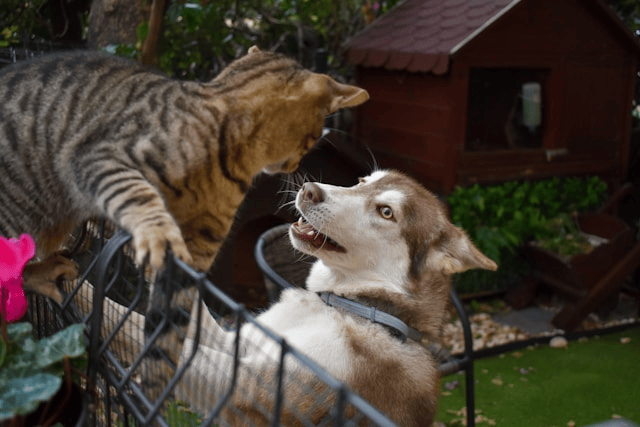Aggression in pets can be frightening and confusing for any pet owner. Whether your dog suddenly growls at strangers or your cat hisses and swipes during handling, aggressive behavior in pets is a serious issue that needs thoughtful attention. It’s important to understand that aggression is usually a symptom of an underlying problem, not simply bad behavior or a “mean” personality.
This guide will help you understand the causes of aggression, how to respond safely, and what you can do to correct or manage the behavior. With time, compassion, and the right approach, many cases of pet aggression can be significantly improved.
Recognizing Aggressive Behavior
Before you can begin to manage aggression, you need to recognize what it looks like and understand what type of aggression your pet may be displaying.
Common types of aggression include:
-
Fear-based aggression: Often triggered when a pet feels cornered or threatened.
-
Territorial aggression: When pets defend spaces like their bed, home, or yard.
-
Possessive aggression: Related to guarding food, toys, or people.
-
Redirected aggression: Occurs when a pet can’t reach the source of frustration and lashes out at someone nearby.
-
Pain-related aggression: Linked to injury or illness.
Signs of aggression in dogs may include: growling, snarling, snapping, lunging, and biting.
Signs in cats may include: hissing, growling, flattened ears, swishing tails, and swatting or biting.
Recognizing early warning signals can help prevent escalation. Pay attention to body language and context many pets will display subtle cues before acting out.
Understanding the Root Causes
Knowing how to stop pet aggression starts with identifying what’s causing it. Aggression is rarely random it usually stems from fear, pain, stress, or past trauma. Some of the most common root causes include:
1. Medical Issues
Pain or discomfort can make even the most affectionate pet act out. Conditions like arthritis, dental disease, or neurological problems may be to blame. Always consult your veterinarian first when sudden aggression appears.
2. Fear and Anxiety
Fear is one of the leading triggers of aggressive behavior in pets. Loud noises, unfamiliar people or animals, or traumatic past experiences can all create an anxious response.
3. Poor Socialization
Pets that weren’t properly socialized during their critical developmental periods may react aggressively to unfamiliar situations, people, or animals.
4. Breed Tendencies and Energy Levels
Some dog breeds are more protective or energetic by nature, which can lead to reactive behaviors if not channeled properly. Understanding your pet’s natural instincts is key.
5. Environmental Stressors
Changes in environment, lack of routine, or overstimulation can all contribute to stress-based aggression. Pets thrive on consistency.
Immediate Steps for Safety
When dealing with aggressive pets, your first priority is safety for yourself, your family, and your pet.
-
Don’t yell or punish. This can escalate the aggression and increase fear.
-
Create distance. Step back slowly and give the animal space.
-
Avoid eye contact. Direct eye contact can be perceived as a threat.
-
Use barriers if needed. Baby gates, crates, or separate rooms can help you manage space safely.
-
Keep children and other pets safe. Supervise interactions and never leave an aggressive pet alone with a child.
Understanding how to deal with aggressive behavior in pets begins with knowing how to defuse tense moments calmly and effectively.
Behavioral Training and Management
If you’re serious about dog aggression training or managing cat aggression, positive reinforcement techniques are the most effective and humane path forward.
Positive Reinforcement
Reward calm behavior and desired responses with treats, praise, or play. This helps build trust and encourages your pet to repeat good behavior.
Desensitization and Counter-Conditioning
Gradually expose your pet to their trigger in a controlled way, pairing it with positive experiences to change their emotional response.
Avoid Punishment
Punishment-based methods (like yelling, leash jerks, or hitting) often increase fear and anxiety, which can worsen aggression.
Use Commands and Consistency
Teach your dog basic obedience commands (like “sit,” “leave it,” or “stay”) to build impulse control. Consistent routines reduce stress and unpredictability.
For cats, encourage appropriate outlets for energy, like playtime, scratching posts, and puzzle feeders.
When to Seek Professional Help
If your pet’s aggression is persistent, escalating, or dangerous, it’s time to call in professionals. Managing pet behavior problems can require a team approach.
Veterinarian
Always rule out medical issues first. Your vet can help you determine if physical pain or neurological problems are contributing to aggression.
Certified Behaviorist or Trainer
Seek someone with experience in managing aggressive dogs or cats, ideally a certified applied animal behaviorist (CAAB) or a professional dog trainer with aggression experience. They’ll develop a custom behavior modification plan tailored to your pet’s needs.
Don’t delay seeking help aggressive behavior often gets worse over time if left unaddressed.
Tips for Preventing Aggression
Prevention is always better than correction. Here are some proactive ways to reduce the chances of aggression developing in the first place:
-
Socialize early. Expose pets to a variety of people, animals, and environments during their formative months.
-
Establish routines. Predictable feeding, play, and rest schedules help pets feel secure.
-
Provide enrichment. Boredom and excess energy are common triggers for aggression. Use toys, puzzles, and regular exercise.
-
Watch for stress signals. Learn to read your pet’s body language so you can intervene before things escalate.
-
Respect boundaries. Don’t force interaction or handling if your pet shows signs of discomfort.
Conclusion
Dealing with aggressive behavior in pets can be challenging and emotional, but it’s important to remember that most pets aren’t naturally aggressive they’re scared, stressed, in pain, or misunderstood. With time, patience, and the right strategy, many cases of pet aggression can be improved or fully resolved.
Whether you’re managing a fear-based growler or a food-guarding feline, help is available, and you don’t have to go it alone. By addressing root causes, staying consistent with training, and knowing when to seek professional help, you can rebuild trust and create a safer, happier environment for both you and your pet.

